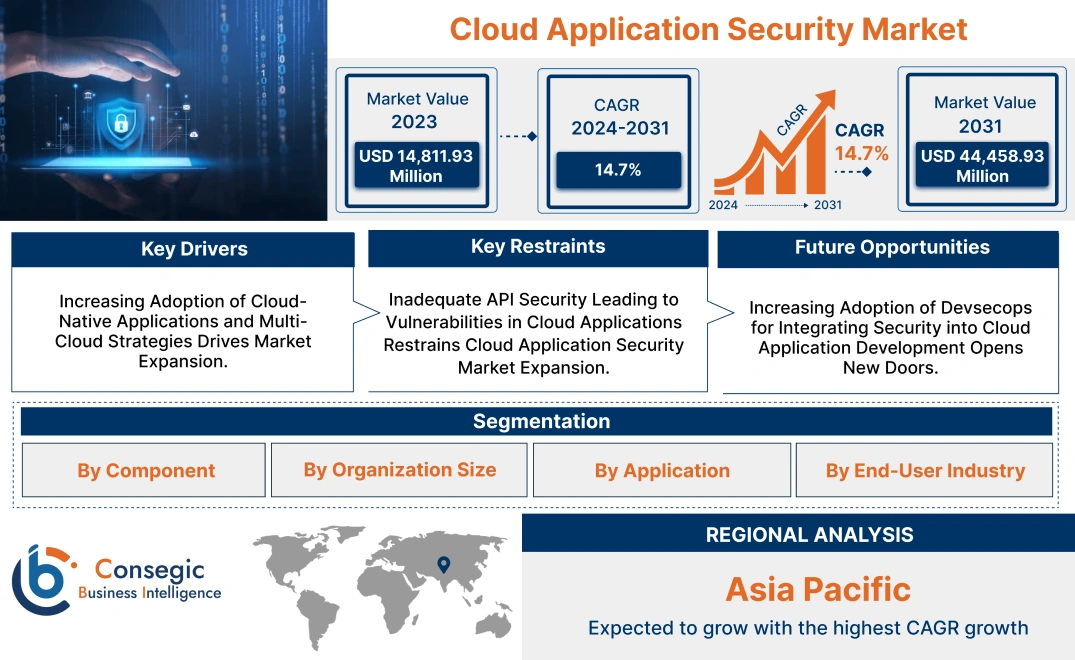- Summary
- Table Of Content
- Methodology
Cloud Application Security Market Size:
Cloud Application Security Market size is estimated to reach over USD 44,458.93 Million by 2031 from a value of USD 14,811.93 Million in 2023 and is projected to grow by USD 16,729.48 Million in 2024, growing at a CAGR of 14.7% from 2024 to 2031.
Cloud Application Security Market Scope & Overview:
Cloud application security refers to the set of tools, policies, and practices designed to protect cloud-based applications from cyber threats, unauthorized access, and data breaches. These solutions ensure the secure operation of applications hosted on cloud platforms by providing features such as identity and access management, data encryption, application monitoring, and threat detection. By addressing vulnerabilities in cloud environments, cloud application security enhances compliance, safeguards sensitive data, and ensures business continuity.
Organizations are implementing these solutions to mitigate risks associated with cyberattacks, enhance visibility into application activity, and protect critical business information. Artificial intelligence (AI) and machine learning (ML) play a critical role in cloud application security by facilitating proactive threat detection and enabling automated responses to potential risks. Key end-users of cloud application security solutions include enterprises across sectors such as IT and telecommunications, banking, financial services, and insurance (BFSI), healthcare, and retail. As businesses continue to embrace cloud technology and prioritize data protection, the market for cloud application security is poised for significant growth, driven by the need for secure and resilient cloud environments.
Cloud Application Security Market Dynamics - (DRO) :
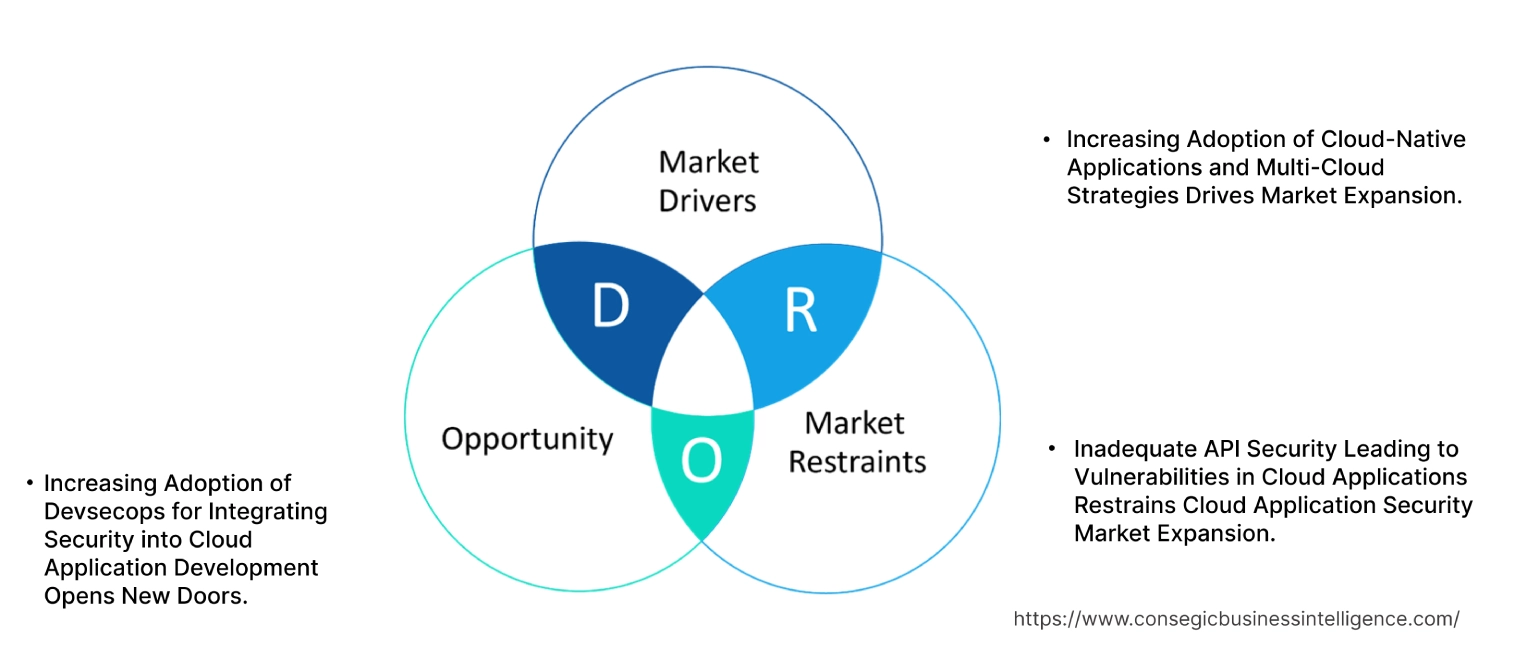
Key Drivers:
Increasing Adoption of Cloud-Native Applications and Multi-Cloud Strategies Drives Market Expansion.
The rapid adoption of cloud-native applications and multi-cloud strategies by enterprises is a significant driver for the market. As businesses shift their workloads to cloud environments and develop cloud-native applications, the need for robust security measures has intensified. Cloud-native architectures, built on microservices and containers, increase the complexity of the IT landscape, requiring specialized security tools to monitor and protect data flows, APIs, and communication channels. Additionally, multi-cloud strategies, which involve using multiple cloud service providers to avoid vendor lock-in and enhance flexibility, introduce new security challenges related to visibility and unified policy enforcement across diverse environments. Cloud application security solutions that offer centralized visibility, integrated threat detection, and automated policy management are in high demand as organizations seek to secure their expanding cloud footprints. In conclusion, the widespread adoption of cloud-native applications and multi-cloud strategies is driving the cloud application security market growth.
Key Restraints :
Inadequate API Security Leading to Vulnerabilities in Cloud Applications Restrains Cloud Application Security Market Expansion.
The increasing reliance on APIs (Application Programming Interfaces) for cloud application integration and communication introduces substantial security risks, as APIs are often targeted by cyberattacks seeking to exploit vulnerabilities. Many cloud applications rely heavily on APIs for functionality, enabling integration with other services, data exchange, and automation. However, poorly managed APIs expose sensitive data, create backdoor entry points, and introduce significant security flaws. Securing APIs is complex, requiring robust access controls, proper authentication mechanisms, and continuous monitoring to detect anomalous activities. Inadequate API security leads to breaches involving sensitive data, such as personally identifiable information (PII) or financial details, impacting the organization's reputation and compliance posture. The difficulty of ensuring comprehensive API security across diverse and evolving cloud environments is a critical barrier to the adoption of cloud application security solutions. Thus, the growing reliance on APIs for cloud application integration presents significant security risks, hampering the cloud application security market demand.
Future Opportunities :
Increasing Adoption of Devsecops for Integrating Security into Cloud Application Development Opens New Doors.
The adoption of DevSecOps practices is creating a significant growth opportunity for the market. DevSecOps integrates security into every stage of the software development lifecycle, emphasizing continuous testing, automated vulnerability scanning, and secure coding practices. As organizations accelerate their cloud application development efforts using agile methodologies and CI/CD pipelines, integrating security early in the development process becomes essential to mitigate risks and ensure compliance. Cloud application security solutions that offer integrated security testing, API protection, and real-time threat intelligence are becoming vital tools for DevSecOps teams. By embedding security checks directly into the development pipeline, businesses detect vulnerabilities earlier, reduce the risk of exposure, and enhance the overall security posture of their cloud applications. The growing emphasis on shifting security left in the development process is driving demand for advanced security tools tailored for DevSecOps environments, particularly in sectors like finance, technology, and e-commerce, where rapid application development is critical. In conclusion, the adoption of DevSecOps practices is driving new cloud application security market opportunities.
Cloud Application Security Market Segmental Analysis :
By Component:
Based on components, the Cloud Application Security Market is segmented into solutions and services.
The solutions segment accounted for the largest revenue of the total cloud application security market share in 2023.
- The solutions category includes core offerings like Cloud Access Security Broker (CASB), Identity & Access Management (IAM), Data Loss Prevention (DLP), and Security Information & Event Management (SIEM).
- CASB solutions enhance visibility and control over cloud applications, helping businesses detect and respond to security threats effectively.
- IAM provides secure access controls, ensuring that only authorized users access critical cloud applications and data.
- DLP solutions prevent data breaches by identifying, monitoring, and protecting sensitive information across cloud environments.
- SIEM integrates real-time monitoring and analytics, offering comprehensive threat detection and response capabilities.
- The dominance of the solutions segment is attributed to the increasing need for advanced security measures to protect cloud applications from sophisticated cyber threats.
- As per cloud application security market analysis, the solutions segment boosts the market progress.
The services segment is expected to register the fastest CAGR during the forecast period.
- Services include consulting, integration & deployment, and support & maintenance, essential for the effective implementation of cloud application security solutions.
- Consulting services help organizations assess their security needs, develop strategies, and select the right solutions tailored to their unique requirements.
- Integration & deployment services focus on seamless implementation, ensuring that security solutions are effectively integrated into existing IT infrastructure.
- Ongoing support & maintenance services provide troubleshooting, updates, and optimization, helping organizations maintain robust security postures.
- The services segment is projected to grow steadily due to the increasing complexity of cloud security environments and the rising demand for expert assistance.
- As per cloud application security market trends, the services segment boosts the market development.
By Organization Size:
Based on organization size, the market is segmented into small & medium enterprises (SMEs) and large enterprises.
The large enterprises segment held the largest market share in 2023.
- Large enterprises typically face complex security challenges due to their extensive IT infrastructure and vast amounts of sensitive data.
- Cloud application security solutions help these organizations address compliance requirements, protect against data breaches, and safeguard intellectual property.
- The increasing adoption of cloud services by large enterprises has driven demand for comprehensive security solutions that provide end-to-end protection.
- Large enterprises benefit from advanced features like real-time threat detection, automated responses, and detailed compliance reporting, which enhance their overall security posture.
- The dominance of the large enterprises segment is due to substantial investments in cybersecurity and the need for scalable, robust security solutions.
- Therefore, as per segmental trends analysis, the large enterprises segment drives the cloud application security market expansion.
The SME segment is expected to register the fastest CAGR during the forecast period.
- SMEs are increasingly adopting cloud application security solutions to protect their data, comply with regulations, and mitigate the risk of cyberattacks.
- The flexibility and lower upfront costs of cloud-based security solutions make them attractive options for smaller businesses with limited IT budgets.
- The growing awareness of cybersecurity threats and the importance of data protection are driving the adoption of cloud application security among SMEs.
- Cloud security solutions offer SMEs the ability to scale their security measures as their business grows, providing a flexible and cost-effective approach to cybersecurity.
- The SME segment is projected to grow steadily, supported by the rising focus on digital transformation and the increasing adoption of cloud services.
- Therefore, as per segmental trends analysis, the SME segment drives the cloud application security market growth.
By Application:
Based on application, the market is segmented into threat protection, access control, data protection, and compliance management.
The threat protection segment accounted for the largest revenue share of 45.82% in 2023.
- Threat protection solutions focus on identifying, mitigating, and responding to a wide range of cyber threats, including malware, phishing, and ransomware attacks.
- These solutions utilize advanced technologies like machine learning and AI to detect anomalies and potential threats in real time, enhancing the security of cloud applications.
- The increasing frequency of cyberattacks targeting cloud environments is driving the adoption of robust threat protection solutions.
- Businesses use threat protection tools to safeguard critical applications, prevent unauthorized access, and ensure the integrity of their data.
- The dominance of the threat-protection segment is due to the rising focus on proactive threat detection and the need to mitigate evolving cybersecurity risks.
- Thus, the threat protection segment is driving the cloud application security market share.
The compliance management segment is expected to register the fastest CAGR during the forecast period.
- Compliance management solutions help businesses adhere to regulatory requirements, such as GDPR, HIPAA, and PCI DSS, ensuring the secure handling of sensitive data.
- These solutions provide automated compliance checks, detailed reporting, and audit trails, simplifying the process of meeting regulatory standards.
- The increasing emphasis on data privacy and the need to avoid penalties for non-compliance are driving the need for compliance management solutions.
- Cloud-based compliance tools offer real-time monitoring and alerts, helping organizations maintain compliance across multiple cloud environments.
- The compliance management segment is projected to grow rapidly due to the heightened focus on data privacy regulations and the increasing complexity of compliance requirements.
- Thus, the compliance management segment fuels the cloud application security market demand.
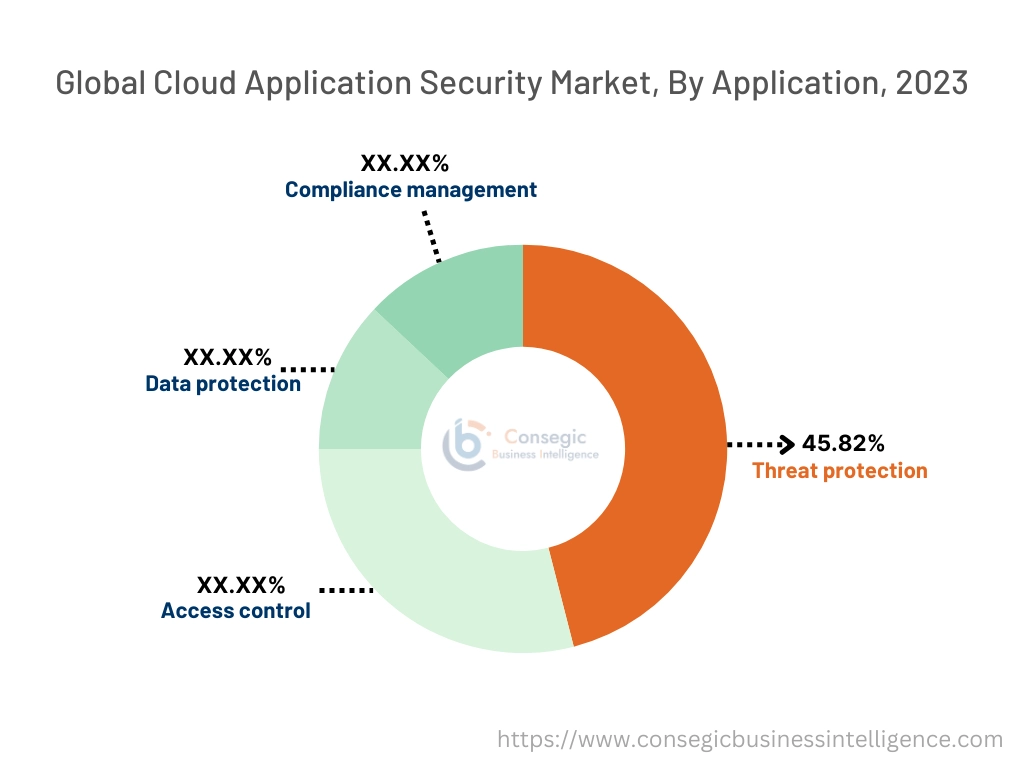
By End-User Industry:
Based on end-user industry, the market is segmented into IT & telecom, BFSI, healthcare, retail & e-commerce, and government & public sector.
The IT & telecom segment accounted for the largest revenue share in 2023.
- The IT & telecom industry is a major user of cloud application security solutions, relying on them to protect vast amounts of customer data and ensure service continuity.
- Cloud security solutions help telecom providers manage and secure their extensive cloud infrastructure, addressing issues related to data privacy and regulatory compliance.
- The increasing use of cloud services and the shift towards 5G networks are driving the adoption of advanced cloud application security solutions in this sector.
- The dominance of the IT & telecom segment is due to its extensive cloud infrastructure and the critical need for robust security measures to safeguard data and services.
- As per cloud application security market trends, the IT & Telecom segment boosts the market development.
The healthcare segment is expected to register the fastest CAGR during the forecast period.
- The healthcare industry requires stringent security measures to protect sensitive patient data and comply with regulations like HIPAA.
- Cloud application security solutions help healthcare providers secure electronic health records (EHRs), protect against data breaches, and ensure patient privacy.
- The increasing adoption of telemedicine and digital health services has accelerated the need for comprehensive cloud security solutions in the healthcare sector.
- The rapid progress of the healthcare segment is driven by the increasing focus on patient data protection, compliance with regulatory standards, and the expansion of digital healthcare services.
- As per cloud application security market analysis, the healthcare segment boosts the market progression.
Regional Analysis:
The regions covered are North America, Europe, Asia Pacific, the Middle East and Africa, and Latin America.
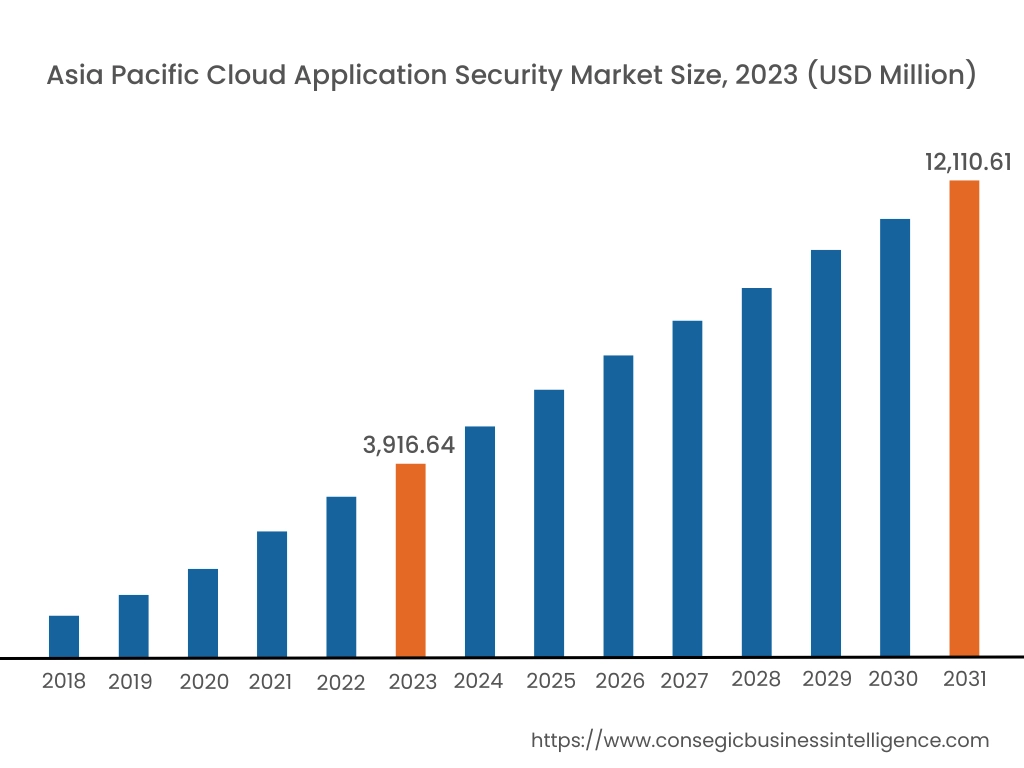
Asia Pacific region was valued at USD 3,916.64 Million in 2023. Moreover, it is projected to grow by USD 4,434.81 Million in 2024 and reach over USD 12,110.61 Million by 2031. Out of these, China accounted for the largest share of 36.9% in 2023. Asia-Pacific is experiencing the fastest growth, driven by rapid digital transformation, increasing adoption of cloud computing, and a rising number of cybersecurity threats in countries such as China, Japan, and India. The region's growing e-commerce sector, along with the increasing use of cloud-based applications in industries like BFSI (Banking, Financial Services, and Insurance) and retail, is fueling the need for advanced cloud application security solutions. Governments across the region are also strengthening data protection laws, which further accelerates cloud application security market opportunities.
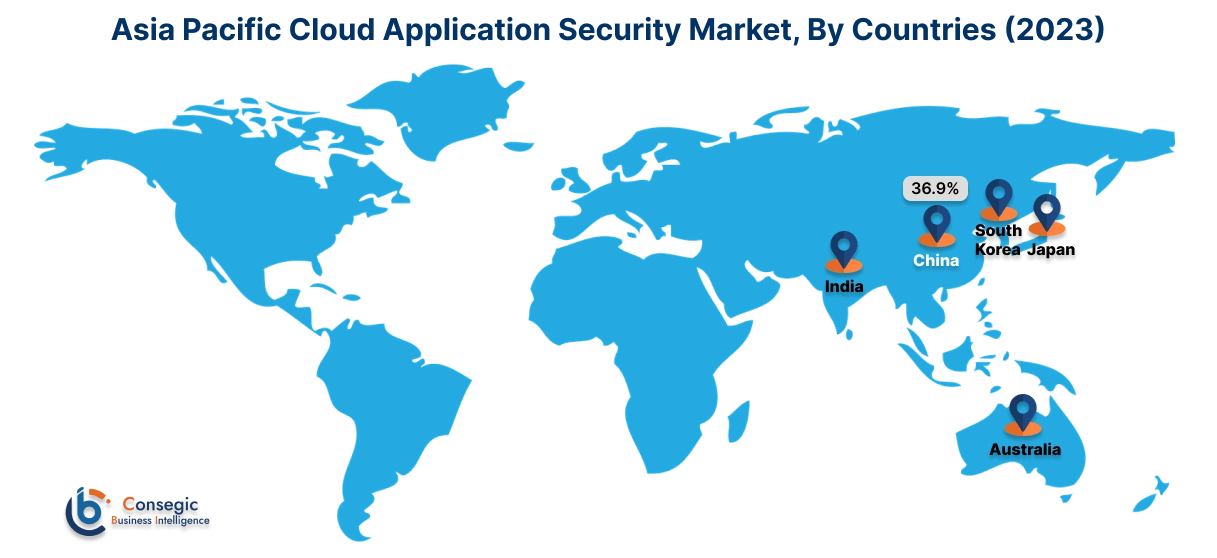
North America is estimated to reach over USD 15,338.33 Million by 2031 from a value of USD 5,054.45 Million in 2023 and is projected to grow by USD 5,714.04 Million in 2024. North America commands a substantial portion of the market, primarily driven by the widespread adoption of cloud services and a strong emphasis on cybersecurity compliance across industries such as finance, healthcare, and IT. The U.S. stands out as a leader, supported by its advanced cybersecurity infrastructure and the presence of major cloud services providers like Microsoft Azure, AWS, and Google Cloud. The growing focus on protecting sensitive data and adhering to regulatory standards such as HIPAA and GDPR further boosts market development.
Europe is a significant player in the cloud application security market, led by countries like Germany, the UK, and France. The region's strict regulations, particularly the General Data Protection Regulation (GDPR), have increased the need for robust cloud application security solutions. Enterprises in Europe are increasingly adopting advanced security measures to safeguard cloud applications against cyber threats and ensure data privacy. Germany's strong industrial base and the UK's financial sector are major adopters of these solutions.
The Middle East & Africa (MEA) region is witnessing steady progress in the market, particularly in Saudi Arabia, the UAE, and South Africa. The adoption of cloud services is on the rise due to digital transformation initiatives and increased investment in IT infrastructure. Saudi Arabia's Vision 2030 and the UAE's push for smart city projects have heightened the focus on securing cloud applications against potential cyber threats.
Latin America is an emerging market for cloud application security, with Brazil and Mexico being key growth drivers. The region's expanding IT sector and increasing adoption of cloud solutions across various industries, including healthcare and retail, are propelling market demand. Brazil's efforts to modernize its cybersecurity framework and Mexico's increasing focus on data protection compliance are encouraging businesses to invest in cloud application security.
Top Key Players & Market Share Insights:
The Cloud Application Security market is highly competitive with major players providing products and services to the national and international markets. Key players are adopting several strategies in research and development (R&D), product innovation, and end-user launches to hold a strong position in the global Cloud Application Security market. Key players in the Cloud Application Security industry include –
- Trend Micro (Japan)
- Qualys (USA)
- Palo Alto Networks (USA)
- Zscaler (USA)
- Lacework (USA)
- Tenable (USA)
- Symantec (Broadcom Inc.) (USA)
- Intruder (UK)
- LookOut (USA)
- Sophos (UK)
Recent Industry Developments :
Product Enhancements:
- In September 2024, Wiz introduced Wiz Code to extend its cloud security platform into developer environments. It integrates security directly into the development lifecycle, from code creation to runtime. The platform helps secure code, CI/CD systems, and cloud infrastructure while providing unified visibility and faster remediation of security vulnerabilities. Wiz Code connects risks in the cloud back to source code and developers, offering a streamlined solution for managing security across the entire development stack. This aims to improve collaboration between security and development teams.
- In June 2024, Datadog introduced new security features for its data cloud and application security platform. These capabilities are designed to offer full-stack security from development to production environments, ensuring enhanced visibility into application and cloud infrastructure. The updates focus on early detection of vulnerabilities during development, runtime threat detection, and improving incident response times, making security an integral part of the software development lifecycle and operational environments.
Partnerships & Collaborations:
- In July 2024, Checkmarx and Wiz partnered to enhance application security through a "code to cloud" integration. This collaboration merges Checkmarx's application security capabilities with Wiz's cloud-native application protection platform (CNAPP). Together, they streamline vulnerability management by correlating application vulnerabilities with cloud runtime data, prioritizing critical risks while reducing unnecessary alerts. The integration enables developers and security teams to work seamlessly, addressing security issues early in development while maintaining visibility across cloud environments.
Acquisitions & mergers:
- In April 2024, Veracode announced the acquisition of Longbow Security to strengthen its cloud-native application security offerings. This integration provides unified visibility and actionable insights across applications, code, and cloud environments, enabling more efficient remediation and risk management. The acquisition is aimed at helping security teams reduce cognitive load by offering a continuous view of their application security posture, improving response times, and lowering organizational risk.
Cloud Application Security Market Report Insights :
| Report Attributes | Report Details |
| Study Timeline | 2018-2031 |
| Market Size in 2031 | USD 44,458.93 Million |
| CAGR (2024-2031) | 14.7% |
| By Component |
|
| By Organization Size |
|
| By Application |
|
| By End-User Industry |
|
| By Region |
|
| Key Players |
|
| North America | U.S. Canada Mexico |
| Europe | U.K. Germany France Spain Italy Russia Benelux Rest of Europe |
| APAC | China South Korea Japan India Australia ASEAN Rest of Asia-Pacific |
| Middle East and Africa | GCC Turkey South Africa Rest of MEA |
| LATAM | Brazil Argentina Chile Rest of LATAM |
| Report Coverage |
|
Key Questions Answered in the Report
How big is the Cloud Application Security market? +
Cloud Application Security Market size is estimated to reach over USD 44,458.93 Million by 2031 from a value of USD 14,811.93 Million in 2023 and is projected to grow by USD 16,729.48 Million in 2024, growing at a CAGR of 14.7% from 2024 to 2031.
What specific segmentation details are covered in the Cloud Application Security Market report? +
The Cloud Application Security market report includes segmentation details for components (solutions and services), organization size (small & medium enterprises and large enterprises), application (threat protection, access control, data protection, compliance management), end-user industry (IT & telecom, BFSI, healthcare, retail & e-commerce, government & public sector), and region.
Which is the fastest-growing application in the Cloud Application Security market? +
According to the analysis, the compliance management segment is expected to register significant growth, driven by increasing focus on data privacy regulations and the need for businesses to adhere to regulatory standards such as GDPR, HIPAA, and PCI DSS.
Who are the major players in the Cloud Application Security market? +
The major players in the Cloud Application Security market include Trend Micro (Japan), Qualys (USA), Palo Alto Networks (USA), Zscaler (USA), Lacework (USA), Tenable (USA), Symantec (Broadcom Inc.) (USA), Intruder (UK), LookOut (USA), and Sophos (UK).
